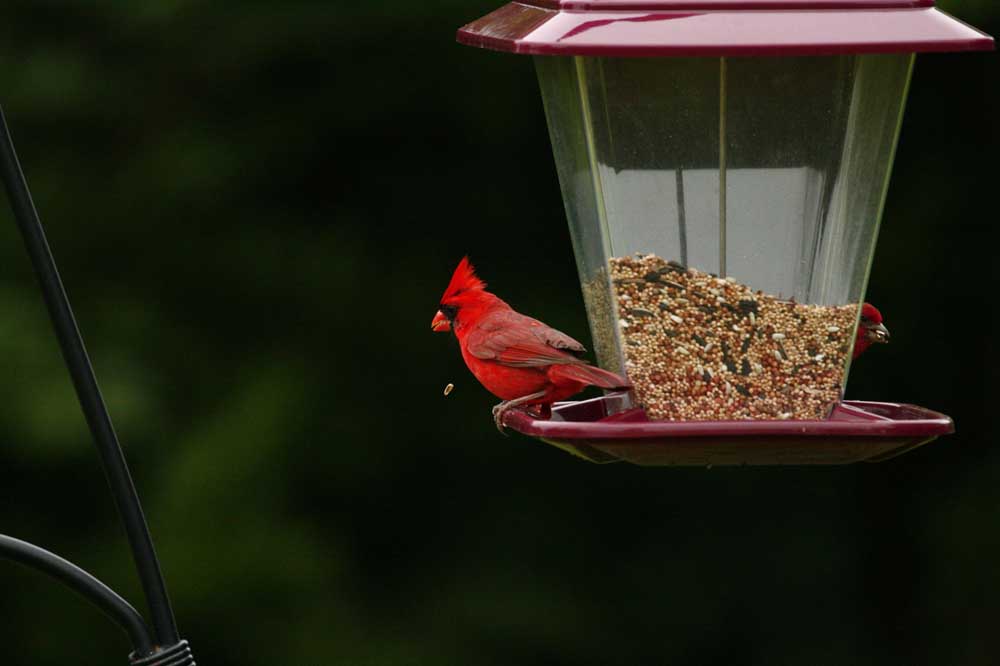Will birdfeeder stall migrating birds?
Published 12:00 am Friday, September 9, 2016

- Tribune News Service / Submitted photoPutting out a feeder now will help migrating birds refuel.
Q: Now that it is September, I want to put my birdfeeder in the yard, but I was told that if I do, it will prevent some birds from migrating south for the winter. Is this true?
A: It is the change in daylight that triggers the urge in a bird to migrate. It has nothing at all to do with food sources. Actually, putting the feeder out now will only help migrating birds as the ones on their way south can stop off at your feeder to refuel and then immediately continue on their journey rather than have to waste time and resources looking for food.
Migrating birds need all the help they can get as they have it hard these days with all the buildings in their way as they travel south.
Q: My uncle passed away recently and I inherited his 15-year-old sun conure. I promised my uncle I would care for Max and I am doing the best I can. After I adopted him, I took him to a vet as I knew nothing about parrots and the vet told me that Max was too fat. My uncle fed him only sunflower seeds and peanuts and the vet said I should give him just a diet of pellets, fruits and vegetables. It took a while to train Max to eat the pellets, but now he does. However the fruits and vegetable part is hard for me as I work two jobs and rarely eat at home. I just do not have the time to go out to buy and cut up fresh produce all the time. I can do apples and carrots as they keep well after they are cut, but do you have any other suggestions?
A: I am in the same situation — so busy these days that the crisper in our fridge rarely has more than a soft mealy apple and a couple of potatoes that are starting to sprout. However I truly believe that some kind of produce is very important to pet birds on a daily basis. It’s not only for the nutrition aspect of it, but many birds get bored on a diet of just pellets and a diet of seed alone is not enough to give them everything they require.
A healthy, well-adjusted bird should look forward to anything new offered to it in speculation that it may be something good to eat. In order to do this, it must have something besides a dish of pellets in its cage. What I do is to get a frozen bag of mixed vegetables and then thaw them out. Most of these packets contain lima beans, string beans, corn, peas and other such vegetables all cut up into small bits. Then I mix the thawed-out vegetables with a can of fruit cocktail packed in juice. I usually do three parts of the vegetables to one part of the fruit cocktail. I just keep this mix in a Tupperware container in the fridge and put a few spoonfuls in each bird cage every morning. The combo is very colorful with the green beans, yellow corn and orange carrots and it attracts the bird’s attention. Although it may not be as nutritious as perfectly fresh produce cut up an hour before it was put in the cage, it is still much better than a mealy apple. Just be sure that you give the bird only what it can eat in one day as any uneaten food like this left on the bottom of the bird’s cage can spoil very quickly and attract fruit flies.
Q: My 2-year-old miniature poodle goes crazy whenever he sees a dog on our large-screen HDTV. He can clearly see that there is a dog on the screen, but I don’t think he can discern that what he is looking at is not the real thing. Our previous dog, a toy poodle, never bothered with the TV, no matter what was on. Was my previous dog smarter then our newer pup? Someone had said the technology of the newer TVs might allow a dog to be fooled into thinking it’s the real thing.
A: Your dog’s behavior has nothing to do with the new TV technologies. Men of higher learning than myself have talked to me until I was dizzy about the “rods and cones” in a dog’s eye and how they cannot see the image on TV as we do. The fact that the TV image has no smell would indicate to the dog that it has no significance at all. Well, I may not have the education that these scientists have, but I do have enough pet-keeping experience to know that a dog does not need to smell a visual image to recognize it.
A perfect example of this is when a dog looks out a closed window of a house and sees a squirrel on the lawn and barks at it. The dog cannot smell the squirrel through the glass, but its brain recognizes that its eyes are looking at a squirrel. I’m not sure how a dog sees the images on a TV screen, but it does see something recognizable as is clear by your dog’s behavior. Why some dogs watch TV and others do not just points out the individuality of dogs. I am sure that the dogs that do not watch TV can see and recognize the images just as well as those that do, but they are just not interested as much or feel that watching them takes them away from more entertaining and stimulating activities like sleeping or pulling Sheetrock off the wall.






